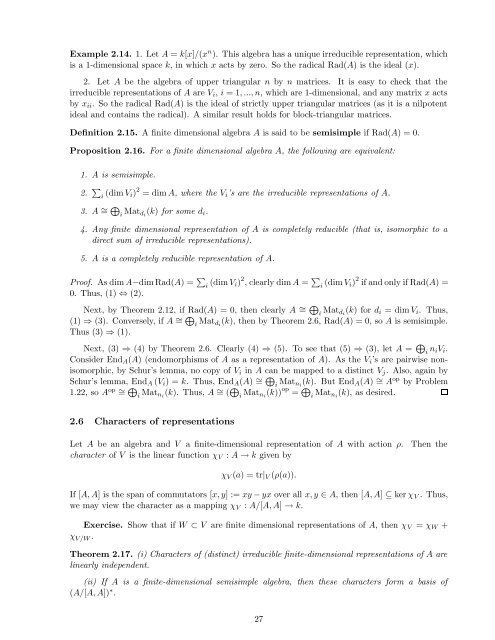Lecture notes for Introduction to Representation Theory
Lecture notes for Introduction to Representation Theory
Lecture notes for Introduction to Representation Theory
You also want an ePaper? Increase the reach of your titles
YUMPU automatically turns print PDFs into web optimized ePapers that Google loves.
Example 2.14. 1. Let A = k[x]/(x n ). This algebra has a unique irreducible representation, which<br />
is a 1-dimensional space k, in which x acts by zero. So the radical Rad(A) is the ideal (x).<br />
2. Let A be the algebra of upper triangular n by n matrices. It is easy <strong>to</strong> check that the<br />
irreducible representations of A are V i , i = 1, ..., n, which are 1-dimensional, and any matrix x acts<br />
by x ii . So the radical Rad(A) is the ideal of strictly upper triangular matrices (as it is a nilpotent<br />
ideal and contains the radical). A similar result holds <strong>for</strong> block-triangular matrices.<br />
Definition 2.15. A finite dimensional algebra A is said <strong>to</strong> be semisimple if Rad(A) = 0.<br />
Proposition 2.16. For a finite dimensional algebra A, the following are equivalent:<br />
1. A is semisimple.<br />
2. ⎨ i (dim V i) 2 = dim A, where the V i ’s are the irreducible representations of A.<br />
3. A ∪ = Mat di (k) <strong>for</strong> some d i .<br />
i<br />
4. Any finite dimensional representation of A is completely reducible (that is, isomorphic <strong>to</strong> a<br />
direct sum of irreducible representations).<br />
5. A is a completely reducible representation of A.<br />
Proof. As dim A−dim Rad(A) = ⎨ (dim V i ) 2 , clearly dim A = ⎨ (dim V i ) 2 i<br />
i<br />
if and only if Rad(A) =<br />
0. Thus, (1) ⊆ (2).<br />
Next, by Theorem 2.12, if Rad(A) = 0, then clearly A ∪ = <br />
i Mat d i<br />
(k) <strong>for</strong> d i = dim V i . Thus,<br />
(1) ≥ (3). Conversely, if A ∪ = i<br />
Mat di (k), then by Theorem 2.6, Rad(A) = 0, so A is semisimple.<br />
Thus (3) ≥ (1).<br />
Next, (3) ≥ (4) by Theorem 2.6. Clearly (4) ≥ (5). To see that (5) ≥ (3), let A = i n iV i .<br />
Consider End A (A) (endomorphisms of A as a representation of A). As the V i ’s are pairwise nonisomorphic,<br />
by Schur’s lemma, no copy of V i in A can be mapped <strong>to</strong> a distinct V j . Also, again by<br />
Schur’s lemma, End A (V i ) = k. Thus, End A (A) ∪ = Mat ni (k). But End = A op A (A) ∪ by Problem<br />
= (k). Thus, A ∪ i<br />
1.22, so A op ∪ Mat ni = ( Mat ni (k)) op = Mat ni (k), as desired.<br />
i i i<br />
2.6 Characters of representations<br />
Let A be an algebra and V a finite-dimensional representation of A with action δ. Then the<br />
character of V is the linear function ν V : A ⊃ k given by<br />
ν V (a) = tr|<br />
V (δ(a)).<br />
If [A, A] is the span of commuta<strong>to</strong>rs [x, y] := xy − yx over all x, y A, then [A, A] ∧ ker ν V . Thus,<br />
we may view the character as a mapping ν V : A/[A, A] ⊃ k.<br />
Exercise. Show that if W → V are finite dimensional representations of A, then ν V = ν W +<br />
ν V/W .<br />
Theorem 2.17. (i) Characters of (distinct) irreducible finite-dimensional representations of A are<br />
linearly independent.<br />
(ii) If A is a finite-dimensional semisimple algebra, then these characters <strong>for</strong>m a basis of<br />
(A/[A, A]) ⊕ .<br />
27

















